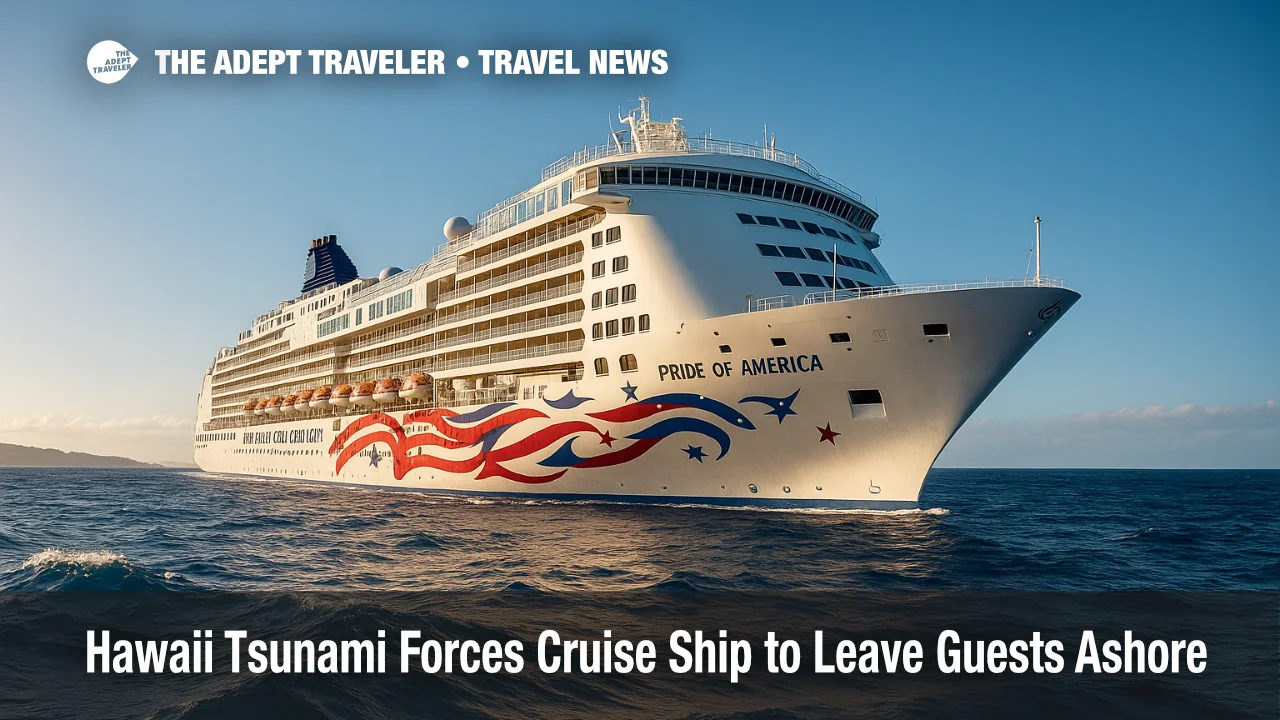Hawaii Tsunami Forces Cruise Ship to Leave Guests Ashore

A powerful undersea quake off Russia's Kamchatka Peninsula sent a tsunami racing across the Pacific on July 29-30, 2025. As warnings rippled outward, the U.S. Coast Guard closed all Hawaiʻi ports and ordered vessels to deep water. Norwegian Cruise Line's Pride of America, berthed at Hilo Harbor, complied, departing two hours early and leaving hundreds of guests on shore excursions to shelter inland. Waves up to six feet reached the Big Island, but caused minimal damage, and the advisory ended overnight. By dawn, inspections cleared Hilo for re-entry and the separated travelers rejoined the ship.
Key Points
- Why it matters: Highlights how maritime safety rules override cruise itineraries during sudden coastal hazards.
- U.S. Coast Guard shut Hilo Harbor under a Pacific-wide tsunami warning.
- Pride of America left early, per protocol, stranding shore-side cruisers temporarily.
- Harbor reopened after an "all clear," allowing reunification by mid-morning July 30.
Snapshot
Seismologists recorded an 8.8-magnitude quake at 124 p.m. HST on July 29 off Kamchatka. The Pacific Tsunami Warning Center escalated a watch to a statewide warning at 243 p.m., citing potential six-foot surges. Norwegian Cruise Line notified passengers that Pride of America would sail at 4 p.m. to reach safe depths beyond Hilo Harbor. Guides escorted roughly 350 stranded guests to high-ground shelters, where county officials provided cots, water, and snacks. The first three-to-five-foot waves arrived shortly after 7 p.m., inundating low-lying parking lots but sparing critical infrastructure. At 10:45 p.m. officials downgraded the warning to an advisory, and the Coast Guard scheduled a daybreak inspection so vessels, including the cruise ship, could return.
Background
Maritime law requires deep-draft vessels to exit harbors when tsunami warnings are issued because long-wavelength waves pose the greatest threat near shore. Once in depths exceeding 600 feet, amplitudes flatten to inconsequential swells. Hilo Harbor, infamous for destructive tsunamis in 1946 and 1960, has strict evacuation triggers. Norwegian Cruise Line keeps Pride of America in Hawaiʻi year-round, making weekly turnarounds at Honolulu and calling at Hilo Harbor every Tuesday. The ship carries U.S. registration, so it falls under Coast Guard jurisdiction. Shore excursions normally require all-aboard by 5:30 p.m., yet the emergency advanced departure to 4 p.m., surprising travelers still at Rainbow Falls, Volcanoes National Park, and downtown Hilo museums.
Latest Developments: Hawaii Tsunami Cruise
Harbor Reopens After Safety Survey
Coast Guard engineers completed a 630 a.m. sonar sweep and pier inspection, finding no structural damage or hazardous debris. Port captain Scott Nelson rescinded the closure at 715 a.m., allowing Pride of America to dock at 8:05 a.m. under tug escort. County buses and tour operators then ferried sheltered passengers back to the pier by 9 a.m., where crew offered breakfasts and fresh linens. Norwegian Cruise Line stated the sailing would continue on its normal inter-island route, adding onboard credits to compensate affected guests. Officials praised the coordinated response among Norwegian Cruise Line, Hilo Harbor staff, and emergency agencies, noting that strict adherence to protocol prevented injuries and vessel damage.
Analysis
Cruise itineraries operate within a complex web of maritime, federal, and local regulations designed to prioritize life and property. The episode demonstrates the non-negotiable nature of tsunami protocols: once the Coast Guard issues a Condition Zulu-equivalent closure, captains must proceed to sea, even if passengers are absent. Historically, vessels trapped in harbors during tsunamis have suffered hull breaches and mooring failures, costing lives and millions in repairs. Norwegian Cruise Line's rapid compliance therefore aligns with best practice, although it creates acute public-relations challenges when travelers feel "abandoned." Providing real-time text alerts, pre-briefing guests on hazard procedures, and partnering with local civil defense for transport and shelter mitigated outrage and preserved safety. For Hawaii tourism, the minimal damage and swift recovery underscore the islands' improving resilience since the devastating 1960 Hilo event. Continued investment in harbor infrastructure, redundant warning systems, and clear visitor education will be critical as seismic threats persist across the Pacific Ring of Fire.
Final Thoughts
The orderly reunion at Hilo Harbor capped a tense night that could have ended far worse. By following established evacuation rules, Norwegian Cruise Line protected its ship and, ultimately, its guests. The Hawaii tsunami cruise incident serves as a timely reminder: when nature moves the ocean, deep water is the only safe harbor.
